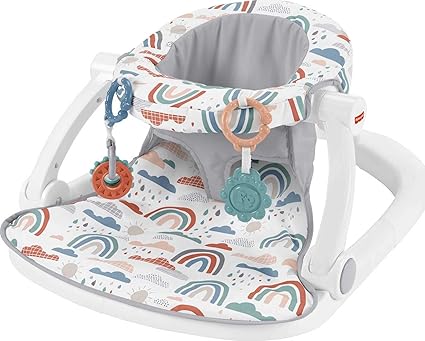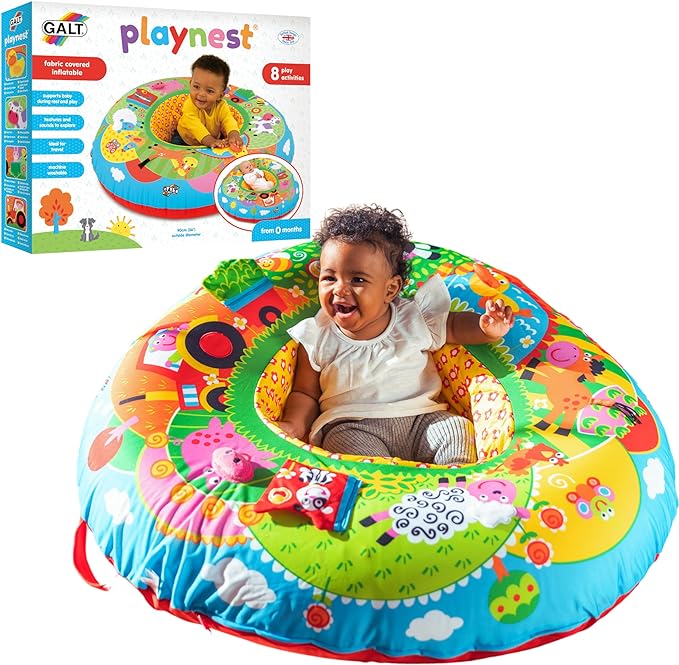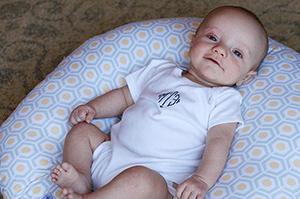Teaching your baby to sit up is an exciting milestone, as it marks the beginning of their journey toward greater independence and mobility. While every baby develops at their own pace, there are several ways you can help support and encourage your little one to achieve this important skill. Here’s a step-by-step guide on how to teach your baby to sit up.
Other Topics You Might Like
Helpful Products You Might Like

Fisher-Price Portable Baby Chair

Galt Toys Playnest Farm Baby

Fisher-Price Laugh & Learn Crawl Around Car
"(Paid Links)" 
Start with Tummy Time
Tummy time is crucial for your baby’s overall development, including their ability to sit up. By spending time on their tummy, babies strengthen their neck, shoulder, and back muscles, which are essential for sitting up. Start with short sessions of tummy time a few times a day, gradually increasing the duration as your baby becomes more comfortable. Encourage your baby by placing toys within their reach or getting down on the floor to interact with them.

Use a Boppy Pillow or Cushion

A Boppy pillow or cushion can provide support as your baby learns to balance while sitting up. Place your baby in a seated position with the pillow wrapped around their lower back. This will help them stay upright while they work on developing the necessary muscle strength and coordination. Always supervise your baby during these sessions to ensure their safety, and gradually reduce the use of the pillow as they gain confidence and stability.
Practice Assisted Sitting
Assisted sitting is another effective way to help your baby learn to sit up. Sit on the floor with your baby between your legs, providing gentle support with your hands around their waist or hips. You can also place your baby on your lap, facing outward, and gently hold their hands as they practice balancing. This gives your baby the opportunity to engage their core muscles and build the strength needed to sit independently.

Encourage Reaching and Grasping

Encourage reaching and grasping activities to help your baby develop the muscles needed for sitting up. Place toys slightly out of reach while your baby is in a seated position or during tummy time. As your baby reaches for the toys, they will naturally engage their core muscles, which are essential for sitting up. Additionally, this practice helps improve hand-eye coordination and fine motor skills.
Incorporate Sitting into Daily Routines
Incorporating sitting into your baby’s daily routines can help them become more comfortable with this new position. For example, during playtime, place your baby in a seated position with toys in front of them. During feeding time, you can use a high chair with proper support, allowing your baby to experience sitting in a secure environment. Gradually, your baby will become more familiar with sitting and develop the strength needed to do so independently.
Use Encouragement and Praise
Positive reinforcement is key when teaching your baby new skills. Offer plenty of encouragement and praise as your baby attempts to sit up. Celebrate their progress, no matter how small, and be patient as they work on mastering this skill. Your enthusiasm and support will motivate your baby to keep trying and build their confidence.
Monitor for Signs of Readiness
It’s important to remember that every baby develops at their own pace, so it’s essential to monitor for signs of readiness. Most babies begin to sit up with support between 4 to 6 months and can sit independently by 7 to 9 months. However, if your baby shows signs of frustration or discomfort, it’s okay to take a break and try again later. Always consult with your pediatrician if you have any concerns about your baby’s development.
In conclusion, teaching your baby to sit up gradually requires patience, encouragement, and plenty of practice. Start with tummy time, use supportive tools like a Boppy pillow, practice assisted sitting, and encourage reaching and grasping activities. Incorporate sitting into daily routines and offer lots of praise to keep your baby motivated. With time and effort, your baby will soon be sitting up independently, ready to explore the world from a new perspective.
